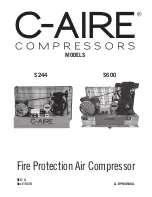
making sure that the keel cooler fits up flush with the hull, chamfering the hole if necessary.
The
rubber O-ring must then be installed and properly seated in the groove provided. Do not install
the Keel Cooler without the rubber O-ring
. Adequate sealant of the correct type must be used, and a
bead applied to the area between the O-ring and the shaft of the Keel Cooler is all that is normally
required. The compressing of the rubber O-ring will serve to force sealant into any voids around the
shaft as the fitting is tightened. Consult your local marine store if you are uncertain of which sealant to
use. With the sintered “Ground Plate” models, a dab of sealant should also be applied to the fore and
aft ends of the Keel Cooler where it meets the hull to secure its orientation. If installing the “Bare
Bones” model, an adequate amount of sealer should be applied under the end fairing cap before the cap
is secured to the hull with screws.
When installing the thread-type Keel Cooler you will need someone to hold the Keel Cooler outside
the boat while you tighten the nut inside.
The mounting location should be carefully chosen. Select
a location with a flat exterior surface, as a concave area will damage the sintering on the Keel
Cooler when it is tightened. Also, avoid areas where lifting slings may be applied or where other
damage may occur. On the boat’s interior, the Keel Cooler should be installed in a location that
is normally dry, and not where it is likely to be submerged or be subjected to frequent and/or
heavy dousing.
Consideration should be given to the fact that the Keel Cooler must be below the water-line, and the
compressor unit must be mounted within 5' of the Keel Cooler location. On power boats it may be
possible to mount the Keel Cooler in a vertical orientation on a section of the transom that is below the
waterline when at rest. Keep the two tubes from the Keel Cooler separate from each other, and do not
insulate them.
It is extremely important to orientate the cylindrical Filter/Drier fitted to the Keel Cooler
discharge tube in a vertical manner, with the arrow pointing downwards. Failure to do so will
lead to poor system performance.
Special constraints and working practices apply when installing the keel cooler on a vessel with a
cored, metal, or carbon fiber hull. For these applications we suggest you consult a marine professional
who is conversant in that particular field.
4:2
Grounding and cleaning
Provision is provided for a grounding/bonding wire to be attached.
It is very important that the Keel
Cooler is electrically connected
to a point that is at the same potential as the boat’s battery
negative,
with no switch in the circuit between the Keel Cooler connection and the battery
negative
. This connecting wire should be green in color and of 8 AWG or higher.
If the Keel Cooler being installed is the type without zincs, it must be connected
to the vessel’s
bonding system and also to a sacrificial zinc anode.
This is an important safety precaution and does
not alter the fact that a connection must be made between the Keel Cooler and a point that is at the
same potential as the boat’s battery negative, whether the Keel Cooler has zincs or not. Bonding wire
should be green in color and of 8 AWG or higher.
If the installer is in any doubt as to how to make the grounding/bonding connections, a marine
electrical technician should be consulted.
The connections must be checked with a multi-meter after installation to ensure that Keel Cooler and
the battery negative post are at the same potential.
The sintered “Ground Plate” Keel Cooler should not be painted unless heavy and consistent fouling
proves to be an issue. Clean occasionally with a brush, never with a metal scraper. All models of Keel
Cooler must be inspected periodically for corrosion.





































